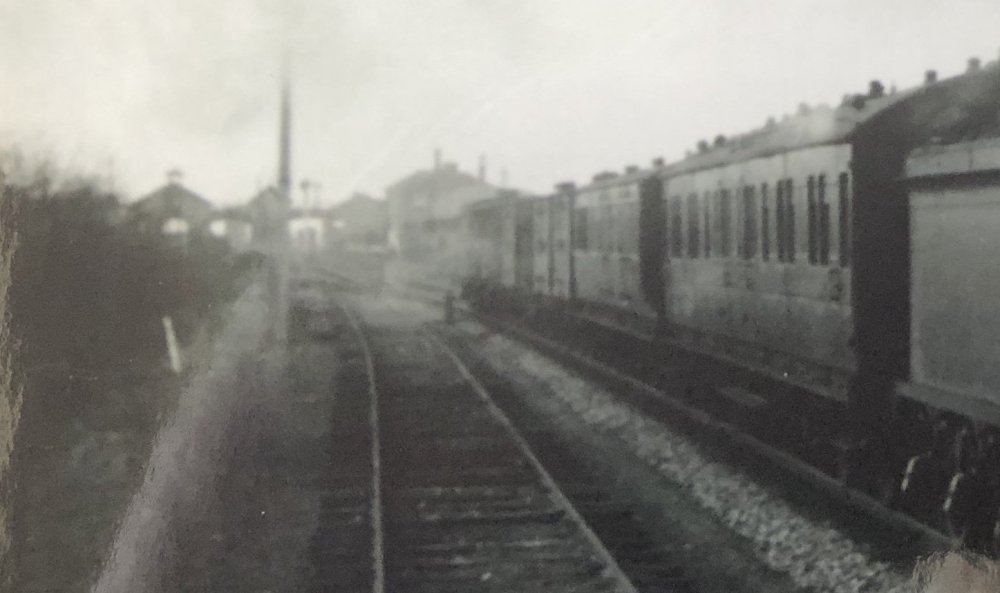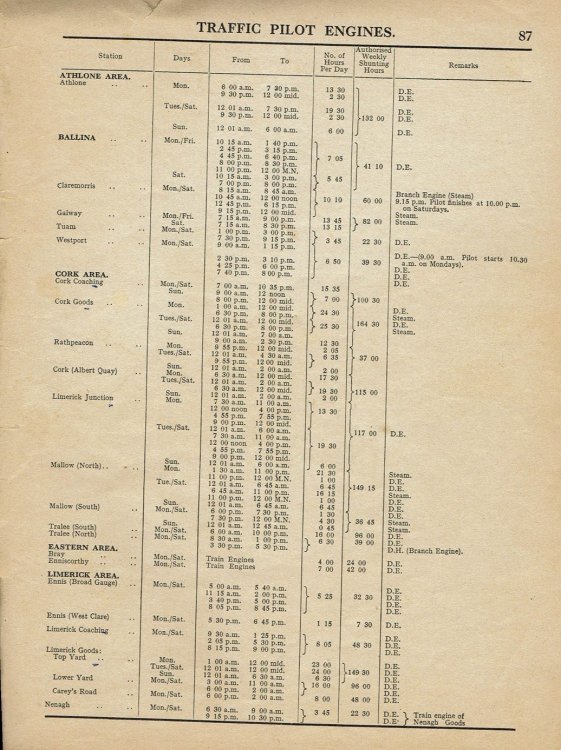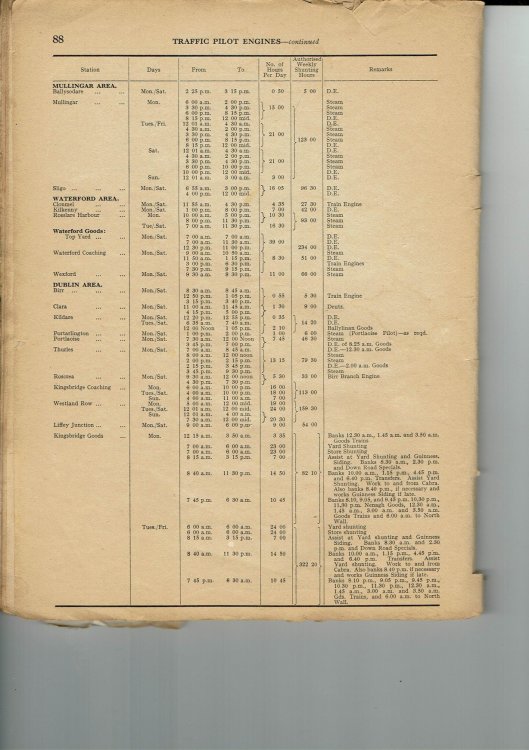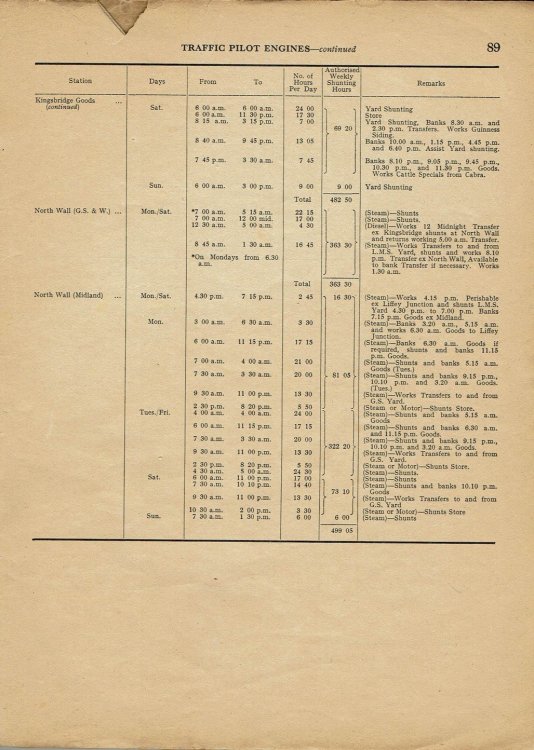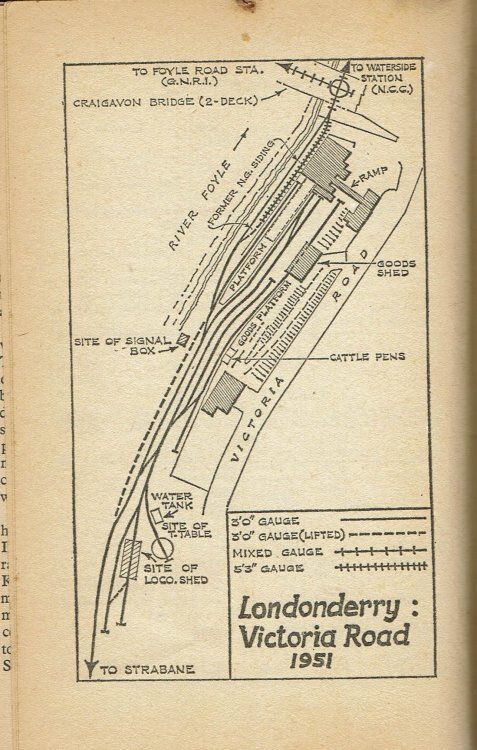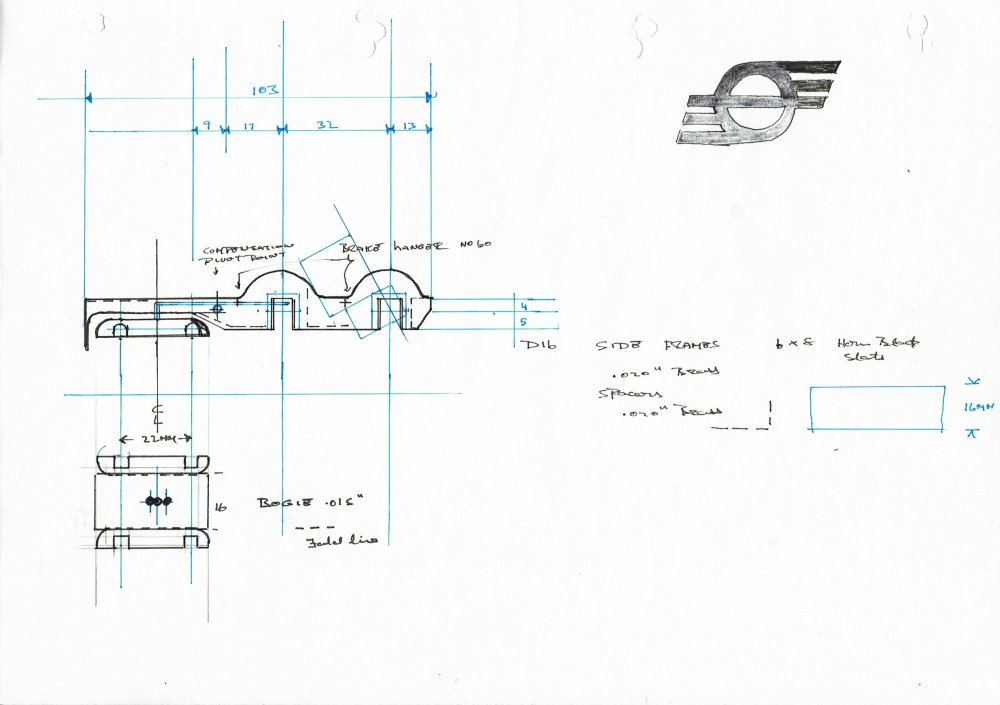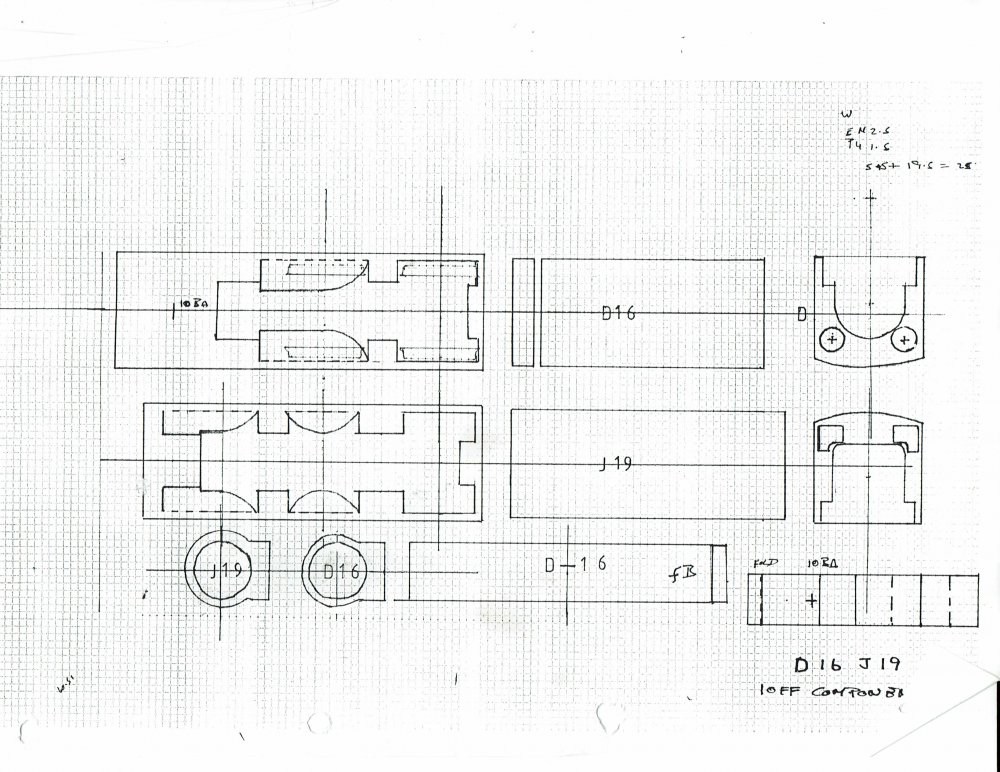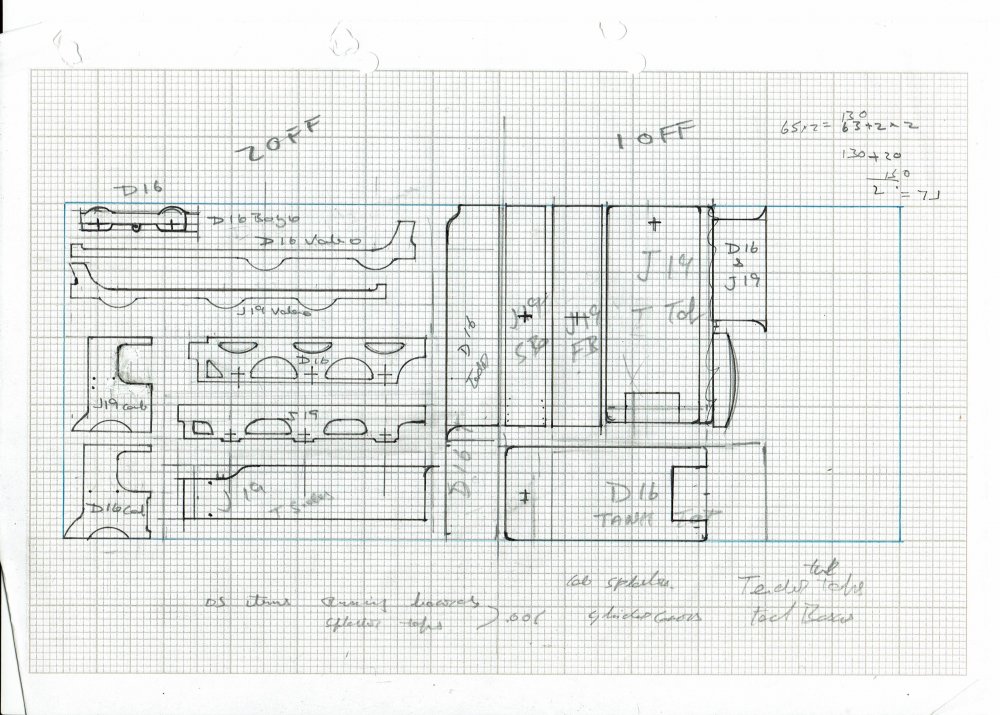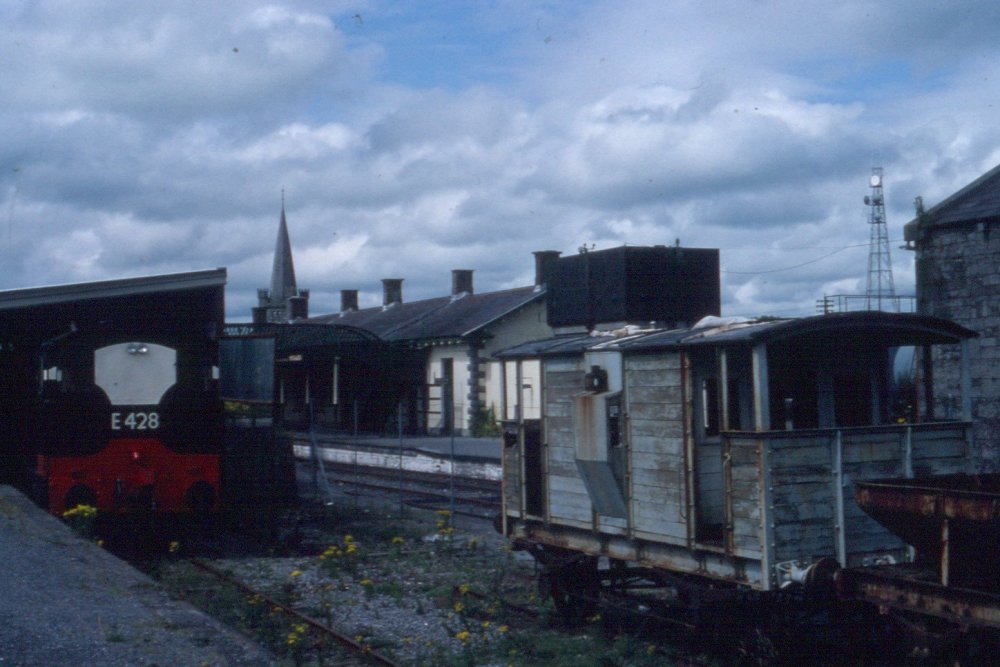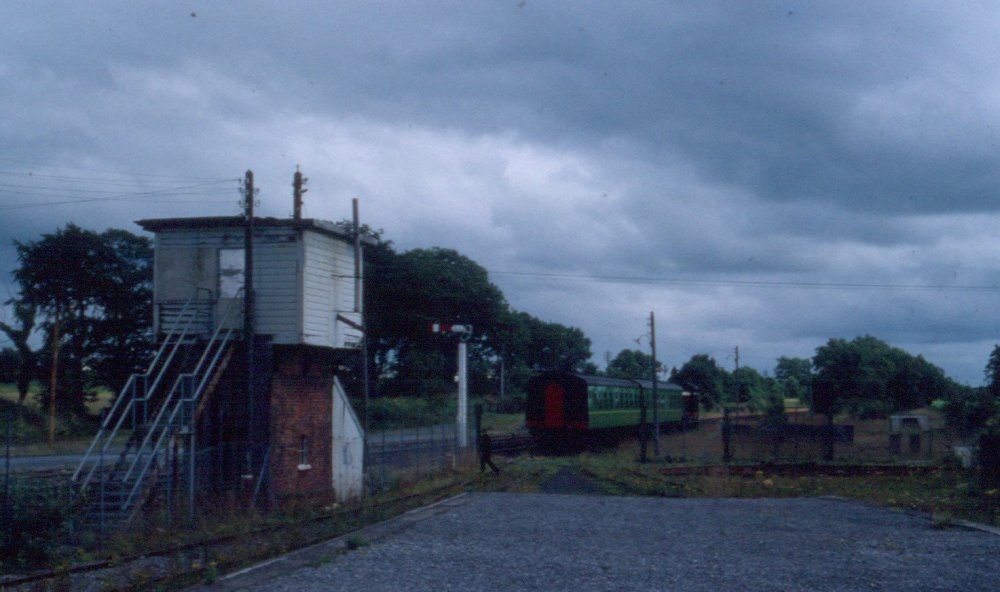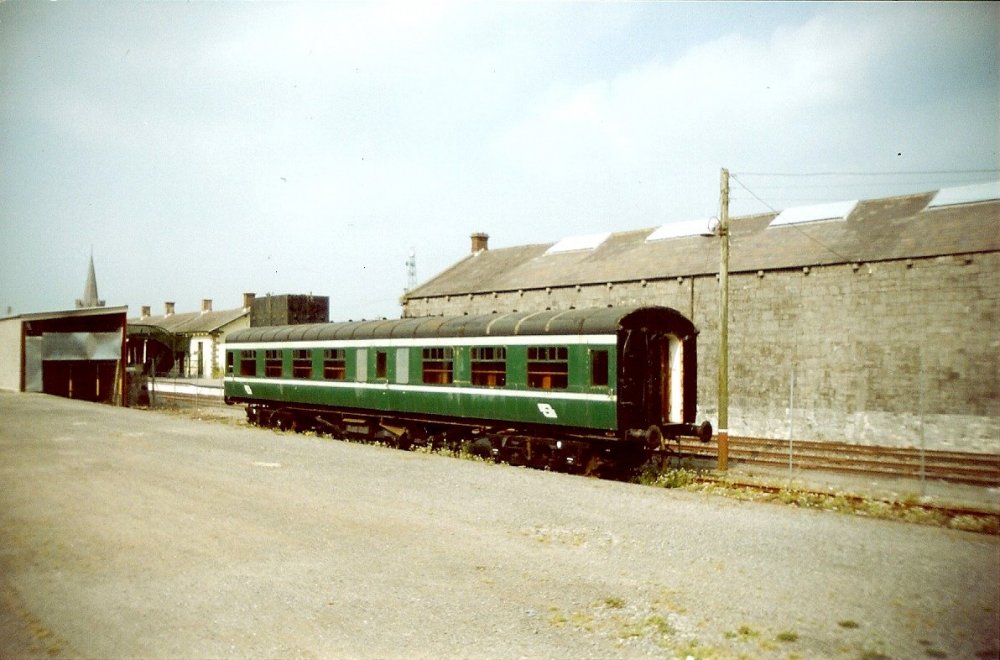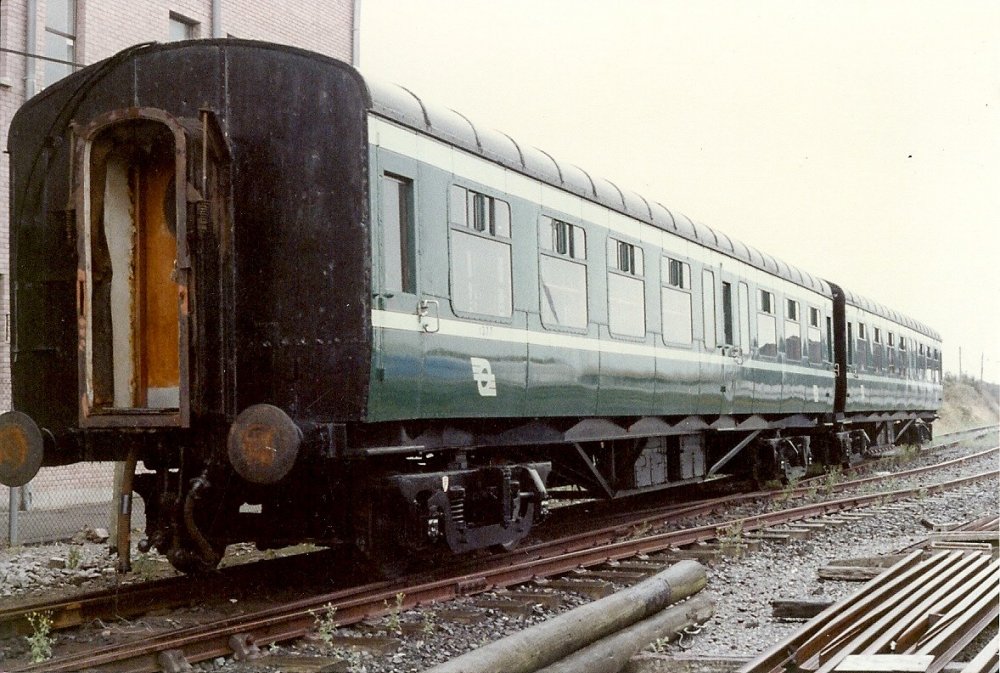-
Posts
4,862 -
Joined
-
Last visited
-
Days Won
119
Content Type
Profiles
Forums
Events
Gallery
Blogs
Store
Community Map
Everything posted by Mayner
-
Jeremy Clements wrote about his experiences in maintaining the locos and stock on the O Gauge Malahide Castle layout in the May 2011 edition of New Irish Lines https://www.dropbox.com/s/4xsw7iaya1qchkr/New Irish Lines - Vol. 6 No. 1 - 2011 May.pdf. It will be interesting to see how contemporary rtr locos and stock perform in similar conditions. The major risk is that replacements for parts that wear out like pick ups, transmission parts, motors and wheel sets are unlikely to be available once the manufacturers stock of spares from the initial production run sells out.
-

Cuisle na Tíre (“Ireland’s Transport Magazine”)
Mayner replied to jhb171achill's topic in General Chat
The most touching feature is the respect the magazine shows that the company still understood and valued the contribution of the individual who carry out humble but critical roles, it would be difficult to imagine a modern day public transport operator doing a similar feature on its staff in a public magazine. -
Here here! I just found out today that a very close relative in Ireland ended up in intensive care after he and his wife caught the dreaded virus, fortunately they both safely made it home.
-
I am inclined to agree with Edo that the photo is of an up train leaving Longford for Mullingar or Broadstone. The position and profiles of the loco shed, carriage shed and signal cabin were unique to Longford, "the churchspire" or blemish is likely to be the post of the down home signal. Longford engine shed had a high almost Spanish mission style cupola smoke vent, a carriage shed existed between the loco shed and down platform into GSR days which with the MGWR style footbridge would have created a twin arch effect. The train consist appears to have been fairly typical of Sligo line trains in GSR days with coaches followed by a string of non-passenger coaching stock possibly Meat or Fish Vans rather than horseboxes.
-
Having finished Aurora and 650 I though it was time to finally finish the test build of 52 Class GSWR No 1 starting with the loco brake assembly. 1st job was to drill out the pin holes 0.7mm for the brake hangers and 0.5mm for the brake shoes, despite the pin chucks struggled to grip an 0.5mm bit despite using the smallest size of collet, pin holders, I eventually used a thin slip of paper as a shim to secure the bit! The GSWR used an unusual double hanger arrangement on the 52 Class which was a bit of a challenge to design, Brake hangers as removed from fret on left, spacing washers folded over and brake shoe removed from hanger on right. Assembly jig using 0.7mm wire drilled through hanger into hardwood block, small drop of oil on wires to prevent soldering wires to hangers during assembly. Hole for 0.45mm wire for securing brake hanger drilled into hardwood block (do not oil wire!) brake shoe and second brake hanger threaded into position. Brake shoe soldered to hangers once correctly positioned and surplus o.45 wire trimmed off. I then removed one of the 0.7mm pins in turn before soldering the ends of the two brake hangers together, then cleared out the hole with a 0.7mm drill or a tapered broach. The brake stretcher bars and pull rods fitted together without a problem, there is sufficient space below the gear wheel when using a High Level Gearbox to bring the ends of the pull rod together below the brake cylinder position. I have not soldered the hangers to the top pivot wires as I prefer to assemble the brale gear as a separate sub assembly to allow the wheels and motor to be removed for maintenance or painting. I accidentally sent a superseded drawing to engraver which omitted the fairing that hides the leading sandbox and fills most of the space between the trailing bogie wheel and leading driver, I will form this part in the traditional way with a piercing saw and files of the test build. Despite a few anxious moments the loco brake gear fitted together without any problems, next stage is to assemble the tender brake gear and add complete detailing of the loco and tender before completing mechanical assembly.
- 392 replies
-
- 10
-

-

-
650 was No 13 Racer 655 was no 29 Clonsilla
-
My main workshop/railway room is in a converted 90 odd year old garage no doubt intended for the owners Model T or Bullnose Morris when our neighbourhood was first established. Although the timber framing and weatherboard was in good condition the building was leaning at an angle when we first moved in as the original foundation piles had rotted away. Several years later having leveled up and re-piled the building, lined and decorated the interior the conversion to a railway room is very much a work in progress, so far this year we have moved out most of my building and woodworking tools to a new workshop and I am planning to replace the existing roller shutter door with something more in keeping with the age and character of the building. Main work area with spray booth/paint shop in foreground and workbench in background. Large scale Loco roster/blackboard. I will remove the scroll saw to the general workshop eliminating the final source of wood dust from the railway workshop. The opposite aisle with the exhaust for the spray booth, traverser for future Irish layout on right. Main modelling workbench, modelling is done on an offcut of kitchen bench top in center, collection of soldering irons in foreground, Unimat set up as vertical drill in distance. Workbench has to be large enough for working on 1:20.3 scale locos & stock and assembling large scale track panels. Yellow storage bins mainly contain 4mm detail castings, & kit scratchbuilding parts. Looking toward the open doorway, jungle taking over outside! My version of the waiting/scrap lines at Inchacore works, the J15s are due to return to the works once I have completed three current projects. 9mm scale NZR loco in background. Opposite side of aisle to main work bench, large scale staging/fiddle yard on lowest level, live steam loco and N gauge layout sitting on baseboard for 4mm layout even more storage above!
-
Traffic Pilot Section from CIE 1960 WTT. At that stage the majority of Pilot Locos were diesel electric most likely C Class with limited use of steam most likely Southern or Midland Standard goods or ex-GNR goods locos in the Dublin area. A steam loco was scheduled as Galway Station Pilot 7:15am -9:00pm Mon-Fri. 7:15am-8:30 Sat Sligo Pilot DE 16 hrs daily 5:55am-12:00 Midnight Mon-Sat with a 1hr break 3-4 pm possibly for a crew change. Ballysodare was allocated a DE pilot loco for 50 minutes daily Mon-Sat 2:25-3:15 to allow the loco of the 03:40 Mullingar-Sligo goods to shunt Pollexfen's Mill sidings.
-
Yep knew it was Sid Vicious but some how or other came up with Johnny Rotten, woke up yesterday with "My My Hey Hey Out of the Blue" running through my head----------got a lot of work done though!!!!!!!!!!!!. To a degree I moved back to Irish modelling I moved back to Irish modelling about 20 years ago, when British outline modelling lost its challenge with the explosion of rtr with Bachmann entering the British market and Hornby shifting production to China. I used to enjoy assembling British outline steam locos from DJH & Comet kits taking 6 months to a year to complete each loco only problem was someone would announce or bring out a rtr version shortly after completing the model, much less of a risk with Irish steam era modelling.
-
A short section of double track was retained on the approaches to Sligo when the Ballysodare-Sligo section was singled following the closure of the SLNCR. The signals and point controlling access to the double track section was power operated from Sligo Cabin. During/following the Civil War the GSWR/GSR developed a system to control junctions remotely using hand generated electricity, the installation was first trailed at Cherryville Junction and later installed to replace signal cabins at branch line junctions including the junctions with the Banagher, Cavan & Macroom branch lines. The control equipment was moved around as junctions were closed or converted to manual operation, Sligo may have received the equipment that controlled the junction with the Banagher branch when the branch was converted to 'One Engine' operation in the late 1950s, Collonney Junction may have received the equipment from Inny Junction following the closure of the Cavan branch in 1963. The train engine performed the run round operation at Sligo at least from the 1970s up to the re-signalling of the station in the early 2000, propelling the train out of the Arrival Platform running round via the points just past the Maugheraboy Road overbridge and propelling back into the Departure Road. The run round of intercity trains was performed in a similar manner at Galway. While there may not have been a loco specifically allocated for shunting or pilot duties at Sligo during the "Supertrain" Era, the train engine of the Night Mail or goods train may have been available for carriage shunting at the station during the trains lay-over. Night Mail Trains operated to both Galway and Sligo up to the early 1990s which would have involved an element of carriage shunting at the station, the Galway Night Mail in its final years ran as a Mail Goods effectively a mixed train with coaching and wagons stock. The older CIE working timetables include a schedule of Pilot Duties for the entire rail system, in some cases the duties were undertaken by a train engine e.g. Nenagh where the loco of the Dublin-Limerick goods was allocated several hours to shunt the yard before continuing to its destination.
-
I wonder if its somewhere on the Midland rather than Harcourt Street. It doesn't look like Broadstone as the line entered a deep cutting before passing under the North Circular Road The make up of the train is pure Midland with an ex MGWR Cs GSR 536 or 540 Class leading and a long string of passenger rated vans behind the second coach, typical of Sligo & Mayo trains. The buildings at Harcourt Street appear to be on a much smaller scale than those in the background, the area on either side of the train appears very rural for the raised section of railway between Adelaide Road and the Grand Canal, the line on the left appears to be a siding rather than a running road. https://irishphotoarchive.photoshelter.com/image/I0000kXkNdsSJDXI.
-
I ended up taking a one way trip to New Zealand but that's another story. IRM , Accurascale focus on selling wagons that will sell in high volumes like block train wagons, where individual customers are likely to want a complete train of the same or similar wagons rather than items like goods brake vans where a customer or collector is likely to only buy one or two of a particular item. If someone believes that their is sufficient demand (2-3000 minimum) for a particular model there is nothing to stop them from commissioning a model direct from a manufacturer or launching a crowdfunding appeal https://www.indiegogo.com/projects/ho-40-single-sheathed-box-and-auto-cars-1929-70s#/. How we intend to spend our modelling/leisure time whether its running rtr trains, building models or simply collecting kits and models is one of life's most important decisions, whatever an individual decides is equally valid and should be respected. While rtr has to a degree decimated kit and component manufacturing, from looking a scratch & kit building threads on IRM, RM Web and other on line groups and on line auction results there is still considerable interest in scratch and kit building, one of the more encouraging things is the interest in scratchbuilding & enthusiasm show by younger modellers entering the hobby like Nelson Jackson and Midland Man. I started out scratchbuilding in the 70s out of pure necessity as much as my interest in the oddball and the obscure as I could not afford to buy rtr Hornby or British Trix models on my pocket money as a teenager or wages while serving my apprenticeship. It took many years to develop my skills to build a half decent model form scratch or a kit (I scrapped or ended up re-working most of my early stuff) and although I got side tracked in many directions I would have not done it any other way. (Not sure whether I am starting to sound like Sinatra or Johnny Rotten singing "I did it my Way" though I would identify more with Johnny Rotten
-
You have hit the jackpot with that one JHB, 64 (427) was one of 6 LNWR Web 4'6" radial tanks purchased by the DWWR for £1500 in 1902 This is what 427 looked like before the Dublin Wicklow and Wexford got their hands on it, and probably explains why the locomotive was not returned to Great Britain with the other 5 members of her class during WW. The DSER rebuilt 64 Earl of Bessborough (427) with a new boiler and cylinders in 1914, resembling a DSER 2-4-2T above the running board with large diameter high pitched boiler & DSER style cab, the smaller 4'6" diameter driving wheels are the main give away to its LNWR origin. https://en.wikipedia.org/wiki/LNWR_4ft_6in_Tank_Class
-
The 1951 diagram in Patterson's book "The County Donegal Railways" indicates that the signal cabin was located beside the river as in the above photo. There does not appear to have been enough space between the running lines to locate the cabin at the end of the platform. Foyle Road would make a very nice model for a compact city terminus standard or narrow gauge. Goods traffic in later years mainly appears to have been fuel oil for the Killybegs Fishing fleet, there are several photos of short cuts (2-3) on narrow gauge tank wagons at Foyle Road and in mixed trains on the Foyle Road-Strabane line. The tank wagons presumably have come across the Harbour Commissioners Tramway and the Foyle Bridge, the Lough Swilly also had a small fleet of tank wagons.
-
I have managed to spread myself around with a home office/model railway room in the house and a converted garage in the garden. The office is the nerve center, library and archive, home for my Irish narrow gauge layout Keadue and lots an lots of junk and clutter. We have high ceilings in our house which gives us a lot of vertical storage. Desk where I do most of my CAD work, roadside section of layout and fiddle yard above. Original modelling workbench on right, storage bins below, Keadue station above. The shelf above the layout is due to be converted to a bookshelf. I am planning to install a lighting pelmet above Keadue to frame the layout better and to reduce dust fallout. The workbench (self assembly kit) was one of the first things in we bought after we arrived in New Zealand looks nice but not very practical. I started the layout shortly after we bought the bench in 2004 and its still incomplete! The other side of the room! The bottom L shaped shelf is due to be cleared for an N Gauge layout, the storage boxes in the center of the room are due to be re-located to the wife's new studio/office in the garden.
-
There is a totally different account of Cs (D6 & D7) performance by Jack O'Neill and Drew Donaldson in a "Decade Of Steam in the Fifties" an RPSI paperback published in the early 70s, where they are described as free steaming but rough riding engines. Jack O'Neill describes firing 540 on the Up Galway mail from Mullingar to Dublin and calls them "fine mainline steeds". Drew describes D6 543 'doing well" with the Claddagh Express in 1953 (a forerunner of the Cu-na-Mara diesel trains) exceeding 70 down Woodlawn bank and knocking 3 minutes off the schedule between Ballinasloe & Athlone with a max of 67½mph and similar exploits with 538 on an up Sligo Night Mail in 1950 and 536 on a Limerick-Dublin train (via Nenagh) in 1939. The poor performing assessment of Midland 4-4-0s appears to have been made by Inchacore engineering staff who were familiar with GSWR loco practice and distrustful of the works of Broadstone, following the introduction of the AEC railcars there was very little work for large 4-4-0s on the Midland system, the majority of Midland and GSWR large 4-4-0s were withdrawn within the same timeframe (1953-1959). Personally the odd thing is that nothing appears to have been done to reduce their rough riding, though the Woolwich Moguls had a similar reputation.
-
I can supply detail castings in pewter or cast brass to order for the smaller MGWR locos including the K, D, P and L Classes https://irishrailwaymodeller.com/topic/8014-650-class-detail-castings-price-list/. I cannot ship at the moment as the majority of businesses in New Zealand are in lockdown to prevent spread of the Coronavirus. At this stage no one is producing castings or detail parts specific to the larger MGWR locos like the A, B, C, F & H Classes though castings for some of the English Railways including the Great Eastern and Great Central may be close, I acquired a set of Great Central "Director" castings many years ago for an F or Midland Cattle Engine. Markits http://www.markits.com/ and Alan Gibson Workshop http://www.alangibsonworkshop.com/ are the two main sources of scratch and kit building parts in the United Kindgom. The Markits locomotive driving wheels have the edge in terms of ease and use durability for OO gauge use. Using tube of a suitable diameter is probably the best option for forming a locomotive boiler, a range of brass tube, plate and shim is produced by KS Precision Metals https://www.ksmetals.com/and is usually stocked by hobby shops. I usually roll steam locomotive boilers with a machine similar to Galtemore's, though its simple enough to roll a boiler or form curves by placing the metal on a resilient surface like an exercise mat or a pad of towels and rolling back and forth with dowel, broom handle or piece of round bar until the metal curves. My tutorial on assembling a Y Boiler should give you an idea of the steps involved in assembling a boiler with a belpaire firebox https://irishrailwaymodeller.com/topic/8223-jmd-belpaire-boiler-assembly/ . I would strongly recommend acquiring a good book on scratch building steam locos John Ahearn's Miniature Locomotive Construction https://www.abebooks.co.uk/book-search/title/miniature-locomotive-construction/author/john-ahern/ and Guy William's The 4mm Engine a Scratchbuilders Guide" https://www.abebooks.com/first-edition/4mm-ENGINE-SCRATCHBUILDERS-GUIDE-WILLIAMS-GUY/17411887838/bd will help guide you through some of the pitfalls in building a loco like a MGWR A or C
-
David: Midland man is planning to build a MGWR C Class 4-4-0 a large Edwardian steam loco not unlike a GER Claud Hamilton rather than a C Class diesel!
-
There are basically two alternatives methods of transferring a design to metal or plasticard. 1. Marking the profile directly on the metal with an engineers scriber, using straightedges and compasses. 2. Gluing a paper pattern to the metal or plasticard, using a craft knife to scribe the cut line. I have used both methods, but prefer to use paper profile to the metal or plasticard for more complex designs. D16 Chassis pattern Marking out the parts for cutting is probably the most critical stage of scratchbuilding a model, as you will need to consider the fit of the various components and the compromises necessary to build a working model, e.g. fitting motor and gear box, will it be necessary to enlarge the splashers to accommodate overscale flanges of OO gauge wheel sets, will it be necessary to cut away part of the boiler/firebox for OO wheel sets, additional clearance required between main frames and bogies to get round the curves on your planned layout. Much of this is challenging and can only be established by experimentation. For cutting out I usually used a piercing saw with a fine toothed blade to cut out the part slightly (.5mm) oversize and finishing to the line with a combination of coarse and fine files 6" and jewllers needle files. Duplicate parts like loco and tender main frames, cab sides, valences, tender sides & underframes are formed by laminating two pieces of brass or nickle silver together, cutting and then separating. I sometimes cut metal parts with a tin snips, but this usually results in more waste clippings than by using a piercing saw as you have to make the initial cut further out from the final cut line and gradually cut up to the line to avoid distortion. I have had little success scribing and snapping sheet metal as I usually use a mininimum of 0.4mm brass or nickle silver I prepared these patterns by hand many years ago and I cannot guarantee their accuracy, these days I prepare the patterns using a CAD programme and use PPD in Scotland to cut out the parts by photo engraving, my MGWR 2-4-0 is designed on similar principals. The biggest challenge with the Midland locos like the C is forming the curved running plate above the crankpin splashers, I usually form this with a shim brass overlay soldered to a flat running board . Although the parts are cut out by etching Scale 7JB thread on building an LNER D16 should give you a reasonable understanding of the challenges involved in scratchbuilding a large 4-4-0 of similar design to the MGWR C with curved running board and similar bogie design. https://www.rmweb.co.uk/community/index.php?/topic/147957-7mm-lner-d163-two-years-down-and-nothing-to-show/
-
The GSR diagrams of MGWR locos were published as a supplement to New Irish Lines several years ago, https://newirishlines.org/ carriage and wagon General Arrangement drawings are available through the IRRS digital collection http://irishrailarchives.ie/index.php/archives/maps_drawings/. Its believe that the MGWR locomotive general arrangement drawings may have been mislaid or destroyed at some stage, many of the carriage and wagon GAs in the IRRS archive are quite faded & some are damaged. If you send me a PM with your personal e-mail address I will forward copies of GSR & Midland loco diagrams.
-
I usually used a micro switch in conjunction with a Seep or Peco point motor to change polarity/achieve reliable power pick up with Peco N gauge points as I found blade contact to be un-reliable.
-
Possibly a coal or cattle special. Coal traffic was likely to have been heavy during the Emergency with up to 3-4 specials daily and cattle specials were run to serve the larger cattle fairs. Mohill, Drumshanbo & Bawnboy Road could each dispatch over 100 wagons for seasonal cattle fairs into the late 1940s Tralee & Dingle 3&4 were drafted in during the Emergency to assist the remaining C&L (6) and Passage Locos (3). The C&L implemented a "time interval" system in conjunction with staff and ticket working to allow up to 3 following trains to occupy the lengthy Drumshanbo-Ballinamore section of the tramway, the GSR streamilned the system during the Emergency installing telephones at Kiltubrid and Ballyduff halts eliminating the time interval element, the system also appears to have been implemented for a short time to allow two following trains to occupy the Ballinamore-Mohill section of the Main Line
-
It sure looks like a CVR guards van! I have to build one to go with my CVR coaches and horsebox. The Donegal bought "5 small vans" & "18 five ton wagons" *along with Railcar 10, "The Unit"(-engine) and other items at an in 1942 auction following the closure of the CVR. The CVR wagons appear to have been rebuilt as vans and listed as "Red Wagons"* for use with the diesel railcars. (* E M Paterson County Donegal Railway & Clogher Valley Railway. The GSR and possibly Irish Turf Board were also present at the auction, the C&L acquired a number of covered and open wagons.
-
I one of the Tralee GSRPS coaches may survive at Dunsandle, both coaches appear to have been transferred to Tuam when attempts to re-open the Fenit line failed. They were 1951-3 CIE side corridor stock I saw them in Tralee in 89 & Tuam in 93. I got a cab ride on E428 a visit to Tuam in July 1993. E428 was shunting carriages into the carriage shed following maintenance, No 90 was waiting for a new boiler to arrive from the UK. Ex GSWR 10T goods brake & MGWR? ballast wagon. The yard was disconnected from the main line and the yard abandoned when I next visited Tuam in 1996 though both the carriage and loco shed were still secure. While the efforts of both Westrail and the GSRPS were largely frustrated much of the rolling stock that was passed to the RPSI, DCDR and survives at Dunsandle would otherwise have been scapped when CIE disposed of redundant rolling stock in the early 1980s. While the GSRPS may appear to have been over ambitious in attempting to overhaul No131 acquiring a large fleet of carriages and attempting to re-open the Fenit branch, this was a once in a lifetime opportunity in terms of setting up a excursion train operation in Munster, Fenit was an ideal site for establishing and maintaining a tourist railway operation. Like Westrail the GSRPS evolved out of a attempts to preserve a disused CIE branch line in this case Cork-Youghal. The 1973 McKinsey Consulting Report on CIE had recommended that a preservation society take over operation of the Summer Sunday seaside excursions trains from CIE, the RPSI had recently started operating the Portrush Flyer excursions setting a precedent for an enthusiast society operating excursion regular excursion trains on the railway system.
-
The Connemara project stands a greater chance of success than Westrail or the Great Southern Railway Preservation Society as it appears to be lead by an enthusiast who also controls the track bed and therefore is not dependent on IE for corridor access. The major difference between Ireland and the UK (& other countries) is that Regional and County Councils have much more autonomy in terms of implementing transport policy and spending money than Ireland. In most Countries Councils are responsible for planning and funding public transport and tourist attractions. Most significantly UK Councils had 1st refusal to acquire disused lines from British Rail while no similar requirement applied in Ireland. Council power to acquire disused lines stimulated the second generation of railway preservation schemes in the UK with Councils leasing disused lines to preservation societies with lines such as the West Somerset, East Lancashire and North Yorkshire Moors Railway. Outside of the UK States and Councils have bought and established tourist railways with commercial operators on disused railway lines including the 64 mile Cumbres & Toltec in Colorado & New Mexico, the 60km Taieri Gorge railway in New Zealand, the restoration of the West Coast Wilderness Railway by the Tasmanian Government https://www.wcwr.com.au/ The best comparison with the latter would be Kerry County Council & the Irish Government funding the rebuilding of the Tralee & Dingle or Valencia Branch to promote tourism in County Kerry post Coronavirus.
.png.c363cdf5c3fb7955cd92a55eb6dbbae0.png)

